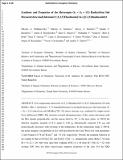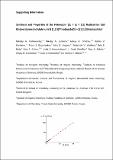Files in this item
Synthesis and properties of the heterospin (S1 = S2 = 1/2) radical-ion salt bis(mesitylene)molybdenum(I) [1,2,5]thiadiazolo[3,4-c][1,2,5]thiadiazolidyl
Item metadata
| dc.contributor.author | Pushkarevsky, Nikolay | |
| dc.contributor.author | Semenov, Nikolay | |
| dc.contributor.author | Dmitriev, Alexey | |
| dc.contributor.author | Kuratieva, Natalia | |
| dc.contributor.author | Bogomyakov, Artem | |
| dc.contributor.author | Irtegova, Irina | |
| dc.contributor.author | Vasilieva, Nadezhda | |
| dc.contributor.author | Bode, Bela Ernest | |
| dc.contributor.author | Gritsan, Nina | |
| dc.contributor.author | Konstantinova, Lidia | |
| dc.contributor.author | Woollins, J Derek | |
| dc.contributor.author | Rakitin, Oleg | |
| dc.contributor.author | Konchenko, Sergey | |
| dc.contributor.author | Ovcharenko, Victor | |
| dc.contributor.author | Zibarev, Andrey | |
| dc.date.accessioned | 2016-06-28T23:31:01Z | |
| dc.date.available | 2016-06-28T23:31:01Z | |
| dc.date.issued | 2015-07-20 | |
| dc.identifier | 196117179 | |
| dc.identifier | bbd29af4-770f-45a0-9d58-fd6a65f769e2 | |
| dc.identifier | 84937689839 | |
| dc.identifier | 000358549300039 | |
| dc.identifier.citation | Pushkarevsky , N , Semenov , N , Dmitriev , A , Kuratieva , N , Bogomyakov , A , Irtegova , I , Vasilieva , N , Bode , B E , Gritsan , N , Konstantinova , L , Woollins , J D , Rakitin , O , Konchenko , S , Ovcharenko , V & Zibarev , A 2015 , ' Synthesis and properties of the heterospin (S 1 = S 2 = 1/2) radical-ion salt bis(mesitylene)molybdenum(I) [1,2,5]thiadiazolo[3,4-c][1,2,5]thiadiazolidyl ' , Inorganic Chemistry , vol. 54 , no. 14 , pp. 7007-7013 . https://doi.org/10.1021/acs.inorgchem.5b01033 | en |
| dc.identifier.issn | 0020-1669 | |
| dc.identifier.other | ORCID: /0000-0002-3384-271X/work/27582728 | |
| dc.identifier.other | ORCID: /0000-0002-1498-9652/work/31779175 | |
| dc.identifier.uri | https://hdl.handle.net/10023/9058 | |
| dc.description | The authors are grateful to the Presidium of the Russian Academy of Sciences (Project 8.14), the Royal Society (RS International Joint Project 2010/R3), the Leverhulme Trust (Project IN-2012-094), the Siberian Branch of the Russian Academy of Sciences (Project 13), the Ministry of Education and Science of the Russian Federation (Project of Joint Laboratories of Siberian Branch of the Russian Academy of Sciences and National Research Universities), and the Russian Foundation for Basic Research (Projects 13-03-00072 and 15-03-03242) for financial support of various parts of this work. N.A.S. thanks the Council for Grants of the President of Russian Federation for postdoctoral scholarship (grant MK-4411.2015.3). B.E.B. is grateful for an EaStCHEM Hirst Academic Fellowship. A.V.Z. thanks the Foundation named after D. I. Mendeleev, Tomsk State University, for support of his work. | en |
| dc.description.abstract | Low-temperature interaction of [1,2,5]thiadiazolo[3,4-c][1,2,5]thiadiazole (1) with MoMes2 (Mes = mesitylene / 1,3,5-trimethylbenzene) in tetrahydrofuran gave the heterospin (S1 = S2 = 1/2) radical-ion salt [MoMes2]+[1]– (2) whose structure was confirmed by single-crystal X-ray diffraction (XRD). The structure revealed alternating layers of the cations and anions with the Mes ligands perpendicular, and the anions tilted by 45°, to the layer plane. At 300 K the effective magnetic moment of 2 is equal to 2.40 μB (theoretically expected 2.45 μB) and monotonically decreases with lowering of the temperature. In the temperature range 2−300 K, the molar magnetic susceptibility of 2 is well-described by the Curie-Weiss law with parameters C and θ equal to 0.78 cm3⋅K⋅mol–1 and −31.2 K, respectively. Overall, the magnetic behavior of 2 is similar to that of [CrTol2]+[1]– and [CrCp*2]+[1]–, i.e. changing the cation [MAr2]+ 3d atom M = Cr (Z = 24) with weak spin-orbit coupling (SOC) to a 4d atom M = Mo (Z = 42) with stronger SOC does not affect macroscopic magnetic properties of the salts. For the XRD structure of salt 2, parameters of the Heisenberg spin-Hamiltonian were calculated using the broken-symmetry DFT and CASSCF approaches, and the complex 3D magnetic structure with both the ferromagnetic (FM) and antiferromagnetic (AF) exchange interactions was revealed with the latter as dominating. Salt 2 is thermally unstable and slowly loses the Mes ligands upon storage at ambient temperature. Under the same reaction conditions, interaction of 1 with MoTol2 (Tol = toluene) proceeded with partial loss of the Tol ligands to afford diamagnetic product. | |
| dc.format.extent | 1227524 | |
| dc.format.extent | 966657 | |
| dc.language.iso | eng | |
| dc.relation.ispartof | Inorganic Chemistry | en |
| dc.subject | QD Chemistry | en |
| dc.subject | DAS | en |
| dc.subject.lcc | QD | en |
| dc.title | Synthesis and properties of the heterospin (S1 = S2 = 1/2) radical-ion salt bis(mesitylene)molybdenum(I) [1,2,5]thiadiazolo[3,4-c][1,2,5]thiadiazolidyl | en |
| dc.type | Journal article | en |
| dc.contributor.sponsor | EPSRC | en |
| dc.contributor.sponsor | EPSRC | en |
| dc.contributor.institution | University of St Andrews. School of Chemistry | en |
| dc.contributor.institution | University of St Andrews. Centre of Magnetic Resonance | en |
| dc.contributor.institution | University of St Andrews. Biomedical Sciences Research Complex | en |
| dc.contributor.institution | University of St Andrews. EaSTCHEM | en |
| dc.identifier.doi | https://doi.org/10.1021/acs.inorgchem.5b01033 | |
| dc.description.status | Peer reviewed | en |
| dc.date.embargoedUntil | 2016-06-29 | |
| dc.identifier.grantnumber | EP/K031252/1 | en |
| dc.identifier.grantnumber | EP/K039210/1 | en |
This item appears in the following Collection(s)
Items in the St Andrews Research Repository are protected by copyright, with all rights reserved, unless otherwise indicated.


